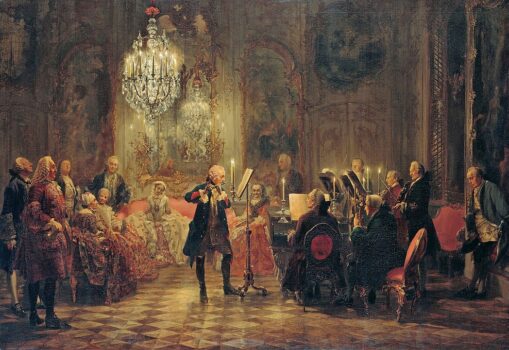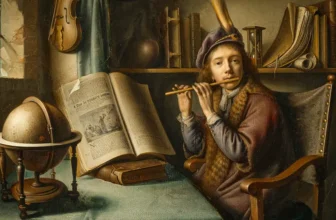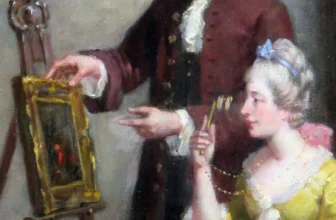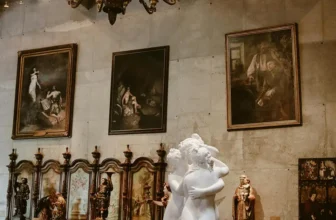The Flute Concert by Adolph Menzel
Shopping Ads: Antique Oil Paintings On Canvas For Sale. Limited Originals Available 💰😊
Authentic hidden masterpieces, Explore old master antique oil paintings from the Renaissance and Baroque eras. From 15th-century to 18th-century Antique Paintings. Bring the Renaissance and Baroque in your home. Shop Now!
🎨 Antique Oil Paintings On Canvas Renaissance, Baroque Art Antique Oil Paintings, Make Offer 16th to 18th Century Portrait Paintings
A Deep Dive into Meaning, Symbolism, and Artistic Interpretation
Adolph Menzel, a prominent German realist painter and illustrator of the 19th century, left behind a vast body of work that captures the socio-political and cultural life of his time. Among his most celebrated and evocative masterpieces is The Flute Concert of Frederick the Great at Sanssouci (German: Das Flötenkonzert von Sanssouci), painted in 1852. This monumental work is more than a historical genre scene, it is a visual symphony that blends portraiture, realism, and symbolic storytelling, bringing to life the courtly splendor, intellectual vibrancy, and artistic aspirations of the Enlightenment era.
In this comprehensive analysis, we’ll explore what The Flute Concert painting is all about, examine its intricate symbolism and narrative layers, and interpret its significance in the broader context of art history. We’ll also identify the painting’s style, compositional elements, and its current location.
What Is The Flute Concert Painting All About?
At first glance, The Flute Concert of Frederick the Great at Sanssouci appears to be a historical scene of musical performance, set in an opulent, candle-lit salon. But this richly detailed composition offers much more than a depiction of music, it presents a snapshot of an era defined by Enlightenment ideals, aristocratic culture, and the personal passion of King Frederick the Great for music, especially the flute.
Painted by Adolph Menzel in 1852, nearly a century after the event it depicts, the work is a historical reconstruction. It shows Frederick the Great of Prussia playing the flute for an intimate audience in the music room of his palace, Sanssouci, in Potsdam. This gathering includes notable figures of the Prussian Enlightenment, such as composers, philosophers, and nobility. The scene is imbued with an air of refinement, with golden light glistening off the gilded moldings and reflecting from the polished floor and fine garments of the audience.
Yet, Menzel is not merely chronicling an event, he is resurrecting an era. The painting reflects the ideal of the “philosopher-king” as imagined during the Enlightenment. Frederick is not just a monarch; he is a man of culture, an artist in his own right. This painting, then, becomes an emblem of Enlightenment aspirations: the harmony of art, intellect, and governance.
What Is Happening in the Painting?
The painting’s composition is carefully orchestrated, as if to mirror the musical structure of the concert itself. At the center of the image, Frederick the Great stands upright, playing his flute. His posture is dignified, yet relaxed, his powdered wig neatly in place. He is bathed in soft, warm light, making him the clear focal point of the composition.
To Frederick’s left and right are seated musicians, notably Carl Philipp Emanuel Bach, the son of Johann Sebastian Bach, at the harpsichord. The chamber orchestra surrounds him, creating a crescent of accompaniment. Behind and around the king are seated members of his court, ladies in richly adorned gowns and gentlemen in formal attire, who listen attentively, their expressions varied, reflecting rapture, thoughtfulness, or quiet contemplation.
The performance takes place in the music room of Sanssouci Palace, a space filled with Rococo elegance. Gilded mirrors, carved furniture, and large windows accentuate the ambiance of a cultivated and sophisticated court. Candlelight flickers throughout the room, not only illuminating the physical space but casting symbolic light on the intellectual enlightenment the court represents.
While the moment is still and silent, the painting seems to pulse with music. One can almost hear the delicate strains of Frederick’s flute and the elegant interjections of the harpsichord. It is a moment of stillness filled with vitality, a private concert transformed into a visual performance for eternity.
Symbolism and Interpretation of the Painting
While The Flute Concert appears to be a straightforward representation of an 18th-century musical event, it is imbued with layers of symbolism that reflect Menzel’s philosophical and artistic intentions.
A. Frederick the Great as a Symbol of Enlightened Monarchy
Frederick the Great was not merely a monarch; he was a thinker, a writer, and a musician. His correspondence with Voltaire and his patronage of the arts positioned him as a central figure of Enlightenment Europe. Menzel uses Frederick’s role as a flautist to symbolize the potential harmony between power and intellect. In this painting, the flute, an instrument of subtlety and elegance, becomes a symbol of enlightened rule.
Frederick does not sit on a throne, issue orders, or inspect troops. Instead, he creates music. He leads not with a scepter, but with breath and melody. This subtle political symbolism would not have been lost on Menzel’s contemporaries, who were grappling with questions about the legitimacy and direction of monarchy in the 19th century.
B. Light and Illumination as Metaphor
Menzel’s masterful use of lighting is a critical element of the painting’s symbolism. The room glows with candlelight, casting a warm hue over the scene. This illumination signifies more than ambiance; it serves as a metaphor for intellectual and cultural enlightenment.
The light that surrounds Frederick, especially, seems to emanate from both physical candles and an inner radiance, a suggestion of his intellectual and artistic vitality. The interplay of shadow and light throughout the room may also reflect the contrast between the private and public, the ephemeral nature of music, and the permanence of memory captured on canvas.
C. Music as Unity and Order
In The Flute Concert, music becomes a metaphor for order, discipline, and unity. Every figure in the scene is linked through the act of listening or playing. Though diverse in class and temperament, the attendees are momentarily united by the performance. This collective engagement with the arts speaks to the Enlightenment ideal of shared human experience through culture and education.
Moreover, music, as an invisible, temporal art, contrasts with the static nature of painting. Menzel, in depicting a moment of music, achieves a paradox: making the ephemeral permanent. In this way, he comments on art’s power to transcend time and medium.
Artistic Style and Technique
Adolph Menzel was known for his realism, but he infused his realism with emotion, narrative, and even theatricality. The Flute Concert is a fine example of historical genre painting, art that depicts a historical event with attention to accuracy, yet presented in a way that conveys the mood and ideals of the era.
Menzel employed oil on canvas with meticulous attention to detail. The rendering of textures, silks, wood, powdered wigs, candle flames, is exquisite. His brushwork is precise yet expressive, capturing not only physical likenesses but the psychological atmosphere of the event.
The composition is carefully balanced, yet naturalistic. Menzel draws the viewer’s eye to Frederick through light, posture, and spatial centrality, but he also invites exploration of the periphery, where smaller dramas and expressions unfold among the audience. There is a sense of authentic spontaneity, a feature that sets Menzel apart from more rigid academic history painters.
Stylistically, the painting sits at the intersection of Romanticism and Realism. It romanticizes the past, but through a realist’s eye. It shows idealized figures in a very tangible, lived-in world. The Rococo setting is faithfully rendered, but there is no overindulgence, Menzel remains committed to capturing the humanity behind the grandeur.
Historical Context and Menzel’s Intentions
Menzel painted The Flute Concert in the mid-19th century, during a time of historical reevaluation. The 1850s were marked by a growing interest in defining what it meant to be German, a cultural identity built not just on language, but on history, philosophy, and art.
By choosing to depict Frederick the Great, a figure celebrated for military prowess but here shown as a patron of the arts, Menzel participates in this cultural project. He reframes Frederick not just as a warrior king, but as a man of taste, refinement, and sensitivity. This portrayal would have resonated with 19th-century audiences who were looking to the past for models of national pride and cultural sophistication.
Menzel, a deeply private man with an intense work ethic, was known for his thorough historical research. His work often blurs the line between illustration and painting. Yet in The Flute Concert, he elevates historical reconstruction into the realm of high art. The painting is not a mere document; it is an interpretation, a philosophical statement.
Where Is The Flute Concert Painting Located Today?
Today, The Flute Concert of Frederick the Great at Sanssouci resides in the Alte Nationalgalerie (Old National Gallery) in Berlin, Germany. It is one of the museum’s prized possessions and a cornerstone of its 19th-century art collection. The painting is celebrated not only for its artistic merit but also for its cultural and historical significance to Germany and to European art more broadly.
Visitors to the Alte Nationalgalerie can experience the painting in person and appreciate its scale, detail, and emotional resonance, elements that are often lost in reproduction. Seeing the painting within the context of other 19th-century German art also allows viewers to appreciate Menzel’s pivotal role in shaping the visual memory of a nation.
The Lasting Power of The Flute Concert
Adolph Menzel’s The Flute Concert of Frederick the Great at Sanssouci is a masterpiece of historical genre painting that transcends its time. It is a painting about art, about leadership, about harmony, both musical and social. It invites us into an intimate moment of beauty and intellectual engagement, portraying the ideal of a world where rulers are artists and where culture reigns alongside politics.
The painting’s symbolism, light as enlightenment, music as unity, Frederick as philosopher-king, speaks to universal themes that continue to resonate. In an age of rapid change and uncertainty, Menzel offers a vision of civility, refinement, and artistic passion.
Through its detailed execution and thoughtful composition, the painting not only documents a historical event but captures a mood, a spirit, and a hope for what society can aspire to be. For this reason, The Flute Concert remains one of the most celebrated and meaningful works of 19th-century European art, a visual ode to the enduring power of culture.




